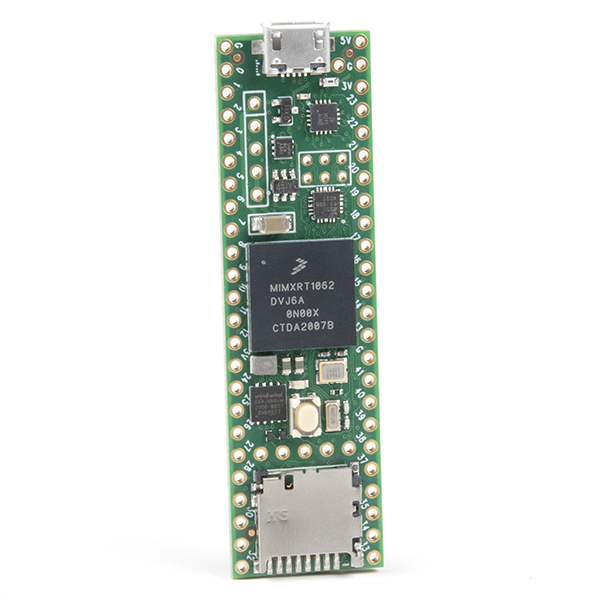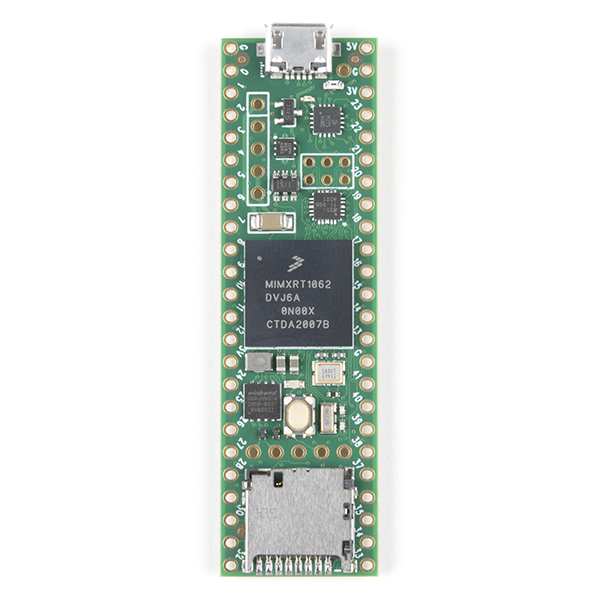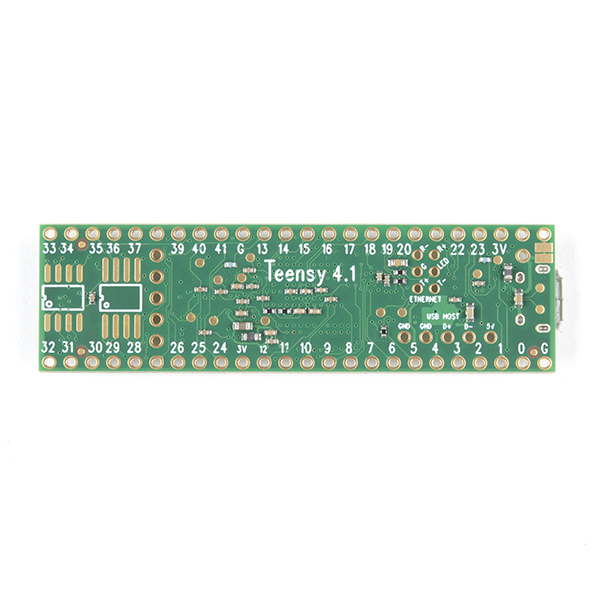The Teensy 4.1 is the newest iteration of the astoundingly popular development platform that features an ARM Cortex-M7 processor at 600MHz, with a NXP iMXRT1062 chip, four times larger flash memory than the 4.0, and two new locations to optionally add more memory. The Teensy 4.1 is the same size and shape as the Teensy 3.6 (2.4in by 0.7in), and provides greater I/O capability, including an ethernet PHY, SD card socket, and USB host port.
When running at 600 MHz, the Teensy 4.1 consumes approximately 100mA current and provides support for dynamic clock scaling. Unlike traditional microcontrollers, where changing the clock speed causes wrong baud rates and other issues, Teensy 4.1 hardware and Teensyduino's software support for Arduino timing functions are designed to allow dynamically speed changes. Serial baud rates, audio streaming sample rates, and Arduino functions like delay() and millis(), and Teensyduino's extensions like IntervalTimer and elapsedMillis, continue to work properly while the CPU changes speed. Teensy 4.1 also provides a power shut off feature. By connecting a pushbutton to the On/Off pin, the 3.3V power supply can be completely disabled by holding the button for five seconds, and turned back on by a brief button press. If a coin cell is connected to VBAT, Teensy 4.1's RTC also continues to keep track of date & time while the power is off. Teensy 4.1 also can also be overclocked, well beyond 600MHz!
The ARM Cortex-M7 brings many powerful CPU features to a true real-time microcontroller platform. The Cortex-M7 is a dual-issue superscaler processor, meaning the M7 can execute two instructions per clock cycle, at 600MHz! Of course, executing two simultaneously depends upon the compiler ordering instructions and registers. Initial benchmarks have shown C++ code compiled by Arduino tends to achieve two instructions about 40% to 50% of the time while performing numerically intensive work using integers and pointers. The Cortex-M7 is the first ARM microcontroller to use branch prediction. On M4, loops and other code which much branch take three clock cycles. With M7, after a loop has executed a few times, the branch prediction removes that overhead, allowing the branch instruction to run in only a single clock cycle.
Tightly Coupled Memory is a special feature which allows Cortex-M7 fast single cycle access to memory using a pair of 64 bit wide buses. The ITCM bus provides a 64 bit path to fetch instructions. The DTCM bus is actually a pair of 32 bit paths, allowing M7 to perform up to two separate memory accesses in the same cycle. These extremely high speed buses are separate from M7's main AXI bus, which accesses other memory and peripherals. 512 of memory can be accessed as tightly coupled memory. Teensyduino automatically allocates your Arduino sketch code into ITCM and all non-malloc memory use to the fast DTCM, unless you add extra keywords to override the optimized default. Memory not accessed on the tightly coupled buses is optimized for DMA access by peripherals. Because the bulk of M7's memory access is done on the two tightly coupled buses, powerful DMA-based peripherals have excellent access to the non-TCM memory for highly efficient I/O.
Teensy 4.1's Cortex-M7 processor includes a floating point unit (FPU) which supports both 64 bit "double" and 32 bit "float". With M4's FPU on Teensy 3.5 & 3.6, and also Atmel SAMD51 chips, only 32 bit float is hardware accelerated. Any use of double, double functions like log(), sin(), cos() means slow software implemented math. Teensy 4.1 executes all of these with FPU hardware.
Note: Please be aware that the Teensy 4.1 does not include headers and will need to be purchased separately and soldered on yourself.
Attention: Due to supply constraints, orders may not be filled immediately; orders not allocated to immediately, will be placed on backorder and filled as inventory allows. If you are a business, distributor, or reseller, please contact sales to place your order: sales@sparkfun.com.
- ARM Cortex-M7 at 600MHz
- 1024K RAM (512K is tightly coupled)
- 8 Mbyte Flash (64K reserved for recovery & EEPROM emulation)
- USB Host Port
- 2 chips Plus Program Memory
- 55 Total I/O Pins
- 3 CAN Bus (1 with CAN FD)
- 2 I2S Digital Audio
- 1 S/PDIF Digital Audio
- 1 SDIO (4 bit) native SD
- 3 SPI, all with 16 word FIFO
- 7 Bottom SMT Pad Signals
- 8 Serial ports
- 32 general purpose DMA channels
- 35 PWM pins
- 42 Breadboard Friendly I/O
- 18 analog inputs
- Cryptographic Acceleration
- Random Number Generator
- RTC for date/time
- Programmable FlexIO
- Pixel Processing Pipeline
- Peripheral cross triggering
- 10 / 100 Mbit DP83825 PHY (6 pins)
- microSD Card Socket
- Power On/Off management
Teensy 4.1 Product Help and Resources
Getting Started with the SmartLED Shield for Teensy
November 9, 2018
In this tutorial, we will connect different RGB LED matrix panels to PixelMatix's SmartLED shield and Teensy.
Getting Started with the Teensy
June 18, 2015
Basic intro to the Teensy line of products, with soldering and programming suggestions.
How to Load MicroPython on a Microcontroller Board
September 4, 2018
This tutorial will show you how to load the MicroPython interpreter onto a variety of development boards.
Core Skill: Soldering
This skill defines how difficult the soldering is on a particular product. It might be a couple simple solder joints, or require special reflow tools.
Skill Level: Rookie - The number of pins increases, and you will have to determine polarity of components and some of the components might be a bit trickier or close together. You might need solder wick or flux.
See all skill levels
Core Skill: Programming
If a board needs code or communicates somehow, you're going to need to know how to program or interface with it. The programming skill is all about communication and code.
Skill Level: Competent - The toolchain for programming is a bit more complex and will examples may not be explicitly provided for you. You will be required to have a fundamental knowledge of programming and be required to provide your own code. You may need to modify existing libraries or code to work with your specific hardware. Sensor and hardware interfaces will be SPI or I2C.
See all skill levels
Core Skill: Electrical Prototyping
If it requires power, you need to know how much, what all the pins do, and how to hook it up. You may need to reference datasheets, schematics, and know the ins and outs of electronics.
Skill Level: Rookie - You may be required to know a bit more about the component, such as orientation, or how to hook it up, in addition to power requirements. You will need to understand polarized components.
See all skill levels
Comments
Looking for answers to technical questions?
We welcome your comments and suggestions below. However, if you are looking for solutions to technical questions please see our Technical Assistance page.
Customer Reviews
4.9 out of 5
Based on 9 ratings:
1 of 1 found this helpful:
New Teensy 4.1 so flexible
I've owned Teensy products in the past, but this one is just the thing for the wheeled robot I'm making. It has multiple serial ports in addition to the main one for connecting to my workstation for uploading programs and watching the monitor port, and it has three I2S ports built in and ready to be used with the modified Arduino libraries. I was easily able to adapt code written for an Arduino UNO with the AVR instruction sets for this powerful processor. I'm expecting that I will be able to use this for integrating all of the sensor data from the robot, all the actuator controls, and communication with a JeVois machine learning vision system and send and receive data on a serial port to an on board RPi running MQTT for higher level pattern matching components. Couldn't be more pleased!
Powerful but requires TLC
Great little board, but you have to solder extra memory and kludge the Ethernet connector.
Best microcontroller I have
You can do pretty much anything with this board. Although you may need external components for WiFi or Bluetooth (if you want that), it has so much processing power and so many peripherals that it's preferable to use this board.
Having USB capability, SDIO and a card slot built in, the i2s ports, and multitude of SPI and I2C busses are some of my favorite features that most microcontrollers don't have. Also can overclock to up to 1Ghz!
This should be used more with projects that need more processing power but don't care too much about the CPU power consumption. Clock speed can be reduced if needed, but it generally uses more power than other Teensys even at lower clock speeds, according to the forums.
Tremendous MCU / cheap and FAST
Crazy fast with lots of inputs/ports. Some SW libraries are still catching up and I was disappointed not to receive the printed pinout diagrams that I received when ordering direct from the manufacturer but overall very happy.
a power house
best arduino dev board, hands down. Best library support and compatibility, fastest, tons of IO and peripherals.
Best small and powerful Mcu
The teensy 4.1 is what I've been hoping for., small but powerful. Maybe what needs to be added is the casing box and supporting boards such as shields.
I love it.
super fast! it's easy to use with Ethernet.
The best arduino… that isn’t!
I don’t know how this is not more talked about, there are like 3 videos and nothing is in more detail as to it’s power and clock cycles, but it’s more than that





Does this come with the pictured magjack? Or can something like the PRT-08534 or BOB-13021 be used with it?
magjack is DIY so far like : OSH Park shared project
Is this a drop-in replacement for the 3.6? Comparing the pinout from the 3.6 and 4.1 it looks like several things have moved. Would be a nice upgrade to an existing project if I don't need to spend $$$ redesigning the mating board.
Indeed things moved :( It is an extended Teensy 4.0 and the 600 MHz 1062 MCU pin function grouping forced changes after the Major bus pins were allocated. USB Host and SDIO and SPI and Serial1 and Wire/i2c stayed in place. But a new mating board doesn't need any underside pad connects and Ethernet is just a magjack away - the underside pads can hold two 8 MB PSRAM chips or a 16 MB Flash {tested so far} with one PSRAM. But like 4.0 no onboard DAC support, and to use the PJRC audio board like the 4.0 takes a new Rev D board to pick up the pins changes.
Novice question... Can I use Software Serial on the 4.1 to get the serials to match the 3.6?
See https://forum.pjrc.com/threads/61559-Does-SoftwareSerial-work-on-Teensy-4-1
Features should show:: 8MB Flash ( not 128MB) and 8 Serial not 7
And the '2 Additional Flash Memory Locations' are different footprint sized like FLASH/RAM and the 8MB PSRAM
Thanks for the catch. Update should be in!